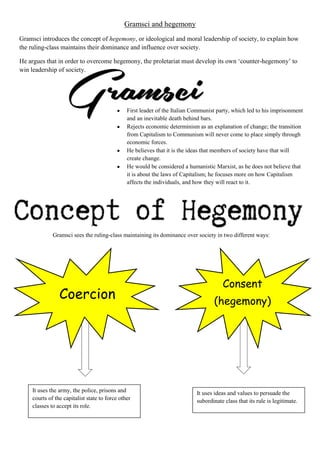
Gramsci and hegemony
- 1. Gramsci and hegemony Gramsci introduces the concept of hegemony, or ideological and moral leadership of society, to explain how the ruling-class maintains their dominance and influence over society. He argues that in order to overcome hegemony, the proletariat must develop its own ‘counter-hegemony’ to win leadership of society. First leader of the Italian Communist party, which led to his imprisonment and an inevitable death behind bars. Rejects economic determinism as an explanation of change; the transition from Capitalism to Communism will never come to place simply through economic forces. He believes that it is the ideas that members of society have that will create change. He would be considered a humanistic Marxist, as he does not believe that it is about the laws of Capitalism; he focuses more on how Capitalism affects the individuals, and how they will react to it. Gramsci sees the ruling-class maintaining its dominance over society in two different ways: Coercion Consent (hegemony) It uses the army, the police, prisons and courts of the capitalist state to force other classes to accept its role. It uses ideas and values to persuade the subordinate class that its rule is legitimate.
- 2. Hegemony and revolution In advanced Capitalist societies, the ruling-class rely heavily on consent to maintain their rule. Gramsci, like Marx, believes that they are able to do so because they control influential institutions, such as popular media, e.g. magazines and forces such as the police force. Thus, regardless of economic conditions seemingly provoking revolution, there will not be one until society no longer accepts ruling-class hegemony. However, the hegemony of the ruling class is never complete, for two reasons: 1. The ruling class are a minority.The rule, they need to create a power bloc by making alliances with other groups, such as the middle-class. Therefore, they make ideological compromises to include those they wish to consider their allies. 2. The proletariat have a dual consciousness.Their ideas are influenced by the bourgeois ideology, but they are also influenced by their experiences, such as poverty. This means that they can partially see through hegemony. Due to these reasons, there is always a possibility of the proletariat overcoming the ruling class hegemony. This is more likely in times of economic crisis, where there is lack of material that will lead the working- class to question the status quo. He argues that this can only happen if the proletariat construct a counter-hegemonic bloc(be able to offer moral and ideological leadership to society). According to his views, the working-class can only win this battle by producing their own ‘organic intellectuals’, meaning a body of workers in the form of a political party who have a different perspective of how society should function. This counter-hegemony would win ideological leadership from the ruling class by offering new ideas of how to run society, allowing it to shift from Capitalism to Socialism. Gramsci is criticised for how much he emphasises the ideas of the individuals and how little he extends upon his idea of the impact of the coercion and fails to regard the significance of economic factors. Example: Workers may wish to overthrow Capitalism, but be reluctant to try because they fear repression from the state or losing their jobs. They may accept hegemony because they feel as if they cannot change it; not simply because they accept the moral leadership. Sociologists working within a Marxist framework have adopted a similar approach to Gramsci, stressing the role of ideas and consciousness and how important it is for resisting dominance and changing society. Example: Paul Willis (1977)describes the working-class lads he studied as ‘partially penetrating’bourgeois ideology- seeing through the school’s ideology to recognise meritocracy as a myth. Writers who draw on perspectives such as interactionism that emphasise the role of ideas and meanings as a basis for action are often named ‘Neo-Marxists.’
- 3. Althusser’s structures: an analogy Ian Carib(1992)uses an analogy to picture the ideas of relative autonomy and two-way casualty. He compares the three levels in Althusser’s model of society to a three-way storey building housing a family business. The family’s living quarters. Standard of living depends on the business below. Their life as a family is not affected by the ground floor, but significant shifts can affect it, such as a divorce meaning the business may be sold off. The shop allows the other floors to be maintained and housed. The office. This is partly affected by the type of shop and how successful it is. It will be organised differently.